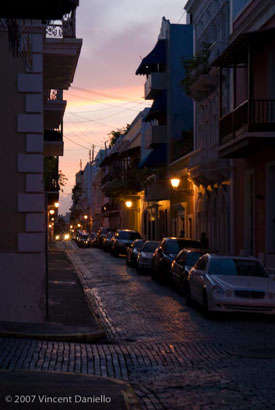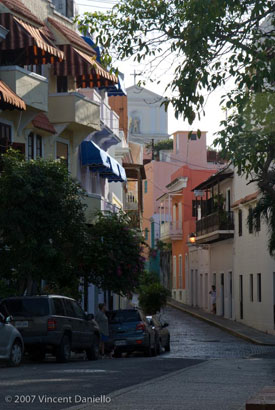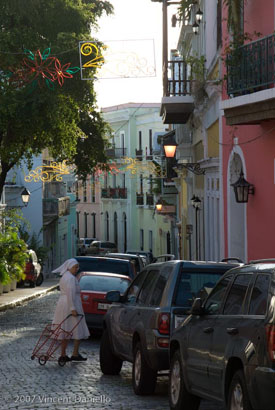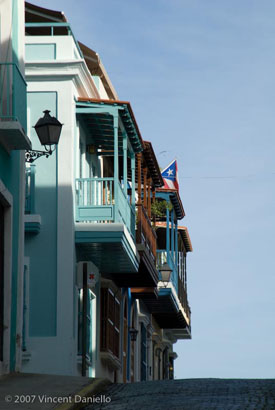
Colors give unique look to Old San Juan
SAN JUAN, P.R.—In a schoolyard one block south of Norzagaray Street and Old San Juan’s austere San Cristóbal fort is a statue of Abraham Lincoln. Miniature compared to the memorial in Washington, D.C., this Lincoln is nearer to the actual size of the man.
His contented expression perseveres despite searing Caribbean temperatures and those who follow his gaze discover across the narrow street a vivid row of houses and small apartment buildings. None of the homes repeat another’s paint shade.
The buildings across the street from the Escuela Graduada Abraham Lincoln are typical of Old San Juan, the tropical community that dates to Puerto Rico’s historic status as a Spanish colony.
 |
On one of Old San Juan’s narrow cobblestone roads at dusk, street lamps provide just enough light to see the colorful buildings and their balconies (Photo by Vincent Daniello). |
From atop his marble throne at the school, Lincoln sees seven side-by-side but vastly different buildings and no evidence of the neighborhood associations that control the appearance of many American homes. From left to right, the buildings are painted shades that could reasonably be described as: blueberry, burned orange, pale green, cyan, violet, yellow and magenta.
Bright purple and blue walls are even evident to those who peer inside a derelict building down the street. In such a colorful city, some may wonder whether the homeowners’ wild selections of paint were produced by games of chance.
Any two colors are likely to appear on neighboring buildings—or even as compliments to one another on the same one—somewhere in Old San Juan. Away from the Lincoln statue, throughout the rest of the community, buildings have been embellished by expressive painters who used such striking colors as deep purple, emerald, ruby red, pea green, sky blue, peach, hot pink and periwinkle blue.
The buildings themselves are typified by “a very modest architecture, very pleasant,” said Tomas Lopez-Gottardi, University of Miami architecture professor and a frequent visitor of Puerto Rico.
“Another feature that is interesting is the color of the stones of the street that have a very shiny gray-blue color,” Lopez-Gottardi added, ”which reminds me the most of Havana.”
He also compared Old San Juan’s aesthetic to that of Cartagena, Colombia, which is another former Spanish colonial port. Lopez-Gottardi said that the buildings of Old San Juan, Havana and Cartagena generally all use clay roof tiles, stucco, wrought iron and wood.
| Clustered together are a group of homes typical of Old San Juan’s brilliant colors (Photo by Vincent Daniello). |
 |
Most houses’ exteriors are smooth, but some are plastered in such a way that they seem to have somehow been fashioned from oatmeal. Since so many colors of paint are used in the community, there are hardly any options for people who want to paint their home in Old San Juan a unique color.
Between the Escuela Graduada Abraham Lincoln and San Cristóbal, on a street barely wide enough to accommodate two-way traffic, a young man wearing glasses and the days-old hint of a beard leaned out of a window to paint his home’s trim. Around noon on a November Saturday, he was applying paint the shade of the primary color blue around the windows and front door of the lime green building.
The hot day’s air was heavy with humidity, and a white van marked with capitalized red letters that spelled the word “hielo,” which is Spanish for “ice,” rumbled down the street. Wasted ice seeped out through the cracks around its doors, leaving a trail of water to sit in the miniature gullies between cobblestones.
Men scooting around the road in small trucks sounded their vehicles’ horns at the ladies walking on the sidewalk. Motor scooters evaded traffic injudiciously, weaving their way ahead of the less wieldy vehicles that contained frustrated-looking people.
Over the drone of nearby careening traffic, the painting man was asked how he chose the arresting combination of bold colors. He paused and elaborately projected thoughtfulness—his fingers stroking his chin—before replying.
 |
A nun in her white habit crosses an Old San Juan road, approaching a veritable rainbow of homes (Photo by Vincent Daniello). |
“Ehh… question, question,” he said slowly, seeming to weigh whether he knew enough English to answer. He appeared to conclude that he did not and he turned to bellow a name toward the back of the building before returning his attention to the trim around the window.
“Maricia!”
The eyes of the middle-aged woman who emerged from another room to stand in the window were such a sedate shade of gray-tinged green that her home’s lime hue appeared to be more radiant than ever by contrast. Like the man painting beside her, she was asked about the building’s unique colors. The question put to her was whether those had always been the colors. Her eyes lit immediately.
“No! We change it every time,” she responded enthusiastically.
To prove her ingenuity as a home decorator, she reported that the building had previously been painted pale blue and dark red with a yellow door.
The bright building in which Maricia and the painting man stood was tidy, an obvious beneficiary of loving attention. Old San Juan’s boisterous colors are not restricted to successful people’s homes, though.
Not far from the home that was being painted lime green and primary color blue is a ramshackle array of buildings known locally as La Perla. The neighborhood teeters precariously on the edge of Old San Juan; indeed, it exists entirely outside of the historic city walls.
In “The Pearl,” buildings that once were painted the same stunning shades as those in the community’s thriving areas are stuffed into the side of a gradual slope that gingerly eases away from town and toward the coast’s violently breaking waves.
 |
With the Puerto Rican flag visible on one of the homes, a series of Old San Juan homes and their imposing balconies stand sentry atop one of the city’s steep roads (Photo by Vincent Daniello). |
La Perla’s negative reputation is well-established. A group of college journalists recently in Old San Juan to visit the National Historic Site was sternly instructed to avoid the neighborhood by the site’s staff. The students were even discouraged from photographing La Perla.
While Maricia’s home was lavished with extra blue paint, people strolling or flying kites on El Morro fort’s expansive lawn could hear sirens emanating from the nearby slum, where the exchange of drugs is said to thrive.
The neighborhood is decrepit, but La Perla’s architecture is not entirely different from that of the rest of Old San Juan. Balconies are as common there as on bustling San Francisco Street, and most of the buildings were at one time as vividly colored as the rest of what is one of the oldest cities in the Western Hemisphere.
Few of La Perla’s colors remain bright in the fading neighborhood. Disheveled DirecTV satellite receivers clutter its skyline, obscuring views of the forts. There is apparently no one like Maricia’s helper to scrape away peeling paint and apply new coats of paint that are the color of tangerines, celery, brown sugar or anything else distinct.
Despite occasional graffiti-laden exceptions, every other neighborhood in Old San Juan is loaded with festive, creatively painted homes. They contrast La Perla’s shabby buildings. As its faded, peeling paint rippled in the strident breeze coming off the ocean one warm Saturday in November, the neighborhood’s reputation preceded itself visually.
The historic area’s neighborhoods that welcome visitors and foot traffic are clearly marked with extravagant house paint. In Old San Juan, it is the areas without bright, imaginative coats of paint that stand out.

Comments are Closed